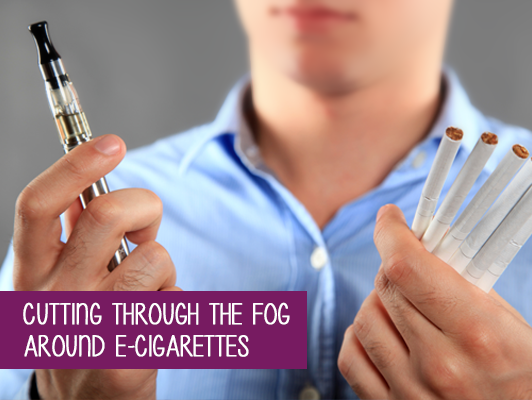Are e-cigarettes safer than cigarettes?
What are e-cigarettes?
Electronic cigarettes. Some models even look like regular cigarettes. They’re also called “personal vaporizers.” People who use these devices may call it “vaping” instead of smoking.
E-cigarettes vs. regular cigarettes
What’s different:
- E-cigarettes contain no tobacco.
- They don’t burn. Instead they heat a water, glycerine, nicotine, and flavor mixture into a vapor that can be inhaled. The water and glycerine mixture is similar to what is made into fog at concerts and Halloween parties.
What’s the same:
- Both deliver nicotine — which is very addictive.
Who uses e-cigarettes?
E-cigarettes are becoming very popular with smokers who:
- Would like to be rid of cigarettes, but are still addicted to nicotine.
- Crave “that feeling” of smoking with their hands, mouths, throats, and lungs.
- Feel insecure about being without cigarettes.
Do e-cigarettes help people quit smoking?
There is currently no scientific evidence that shows they help. If the goal is to quit smoking cigarettes by vaping, and then quit vaping, it doesn’t look good. So beware of unproven claims by e-cigarette companies. Their devices are nicotine delivery systems, just like cigarettes. You can become addicted to nicotine no matter how it’s delivered. The manufacturers are counting on that.
Are e-cigarettes harmful?
Maybe; it’s too early to tell. If you consider vaping an option, keep in mind that:
- Water and glycerine fog mixes are generally considered safe, but there is no science studying the effects of taking in a concentrated dose several times daily over an extended period.
- Even if a mixture is shown to be safe (and it will take a long time to determine that), there are currently no regulations in place to make sure that the mixtures are standardized. They could vary by manufacturer. They could even change by mistake or at the whim of a manufacturer.
- There is no standardization of the devices, either. Some kinds of e-cigarettes have been known to explode or catch fire. In some cases the chargers failed or were mixed up with other devices. In other cases the devices themselves were faulty.
- Nicotine, along with being addictive, is toxic. The vaping cartridges often come as colored liquids, which are attractive to young children. In 2014, poison center calls related to e-cigarettes averaged 215 per month.
- Users often complain of sore mouths and throats, as well as nausea and vomiting.
- The action of vaping still looks like smoking. It will likely be met with the same social disapproval, since people around you still have to smell and inhale the product.
That’s a lot to think about. Now consider the fact that many nicotine replacement products, like the patch, the gum, or the lozenge, are also sold over the counter. They also reduce nicotine withdrawal, but without the sharp spikes in nicotine delivery. These nicotine replacement products are designed to help you become free of nicotine, not keep you coming back for more.
If the feeling of holding something in your hand and inhaling from it is what you have a hard time giving up, consider a nicotine inhaler. They are hand-held and shaped like a cigarette. They require a prescription, so talk to your doctor. Again, the inhalers are designed to help you ultimately quit using nicotine.
Find out if your insurance plan has incentives to quit smoking at 1-888-876-2756. Your employer may have discounts for smoking cessation products, including over-the-counter medicines like nicotine gum, lozenges, or patches. UPMC employees, for instance, can get credit toward Take a Healthy Step by participating in one of our many tobacco cessation programs.
Want more information and support for your quit attempt? Call a health coach at 1-800-807-0751.




